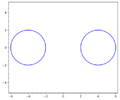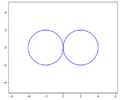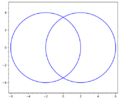Difference between revisions of "Persian curve"
From Encyclopedia of Mathematics
(TeX) |
(svg picture) |
||
| (One intermediate revision by the same user not shown) | |||
| Line 2: | Line 2: | ||
''spiric curve'' | ''spiric curve'' | ||
| − | A plane algebraic curve of order four that is the line of intersection between the surface of a torus and a plane parallel to its axis (see | + | A plane algebraic curve of order four that is the line of intersection between the surface of a torus and a plane parallel to its axis (see Figures). The equation in rectangular coordinates is |
$$(x^2+y^2+p^2+d^2-r^2)^2=4d^2(x^2+p^2),$$ | $$(x^2+y^2+p^2+d^2-r^2)^2=4d^2(x^2+p^2),$$ | ||
| − | where $r$ is the radius of the circle describing the torus, $d$ is the distance from the origin to its centre and $p$ is the distance from the axis of the torus to the plane. The following are Persian curves: the [[ | + | where $r$ is the radius of the circle describing the torus, $d$ is the distance from the origin to its centre and $p$ is the distance from the axis of the torus to the plane. The following are Persian curves: the [[Booth lemniscate]], the [[Cassini oval]] and the [[Bernoulli lemniscate]]. |
| − | < | + | <gallery> |
| − | + | File:Courbe persane 042.svg|$d>r$ | |
| − | + | File:Courbe persane 022.svg|$d=r$ | |
| − | + | File:Courbe persane 024.svg|$d<r$ | |
| − | $d>r$ | + | </gallery> |
| − | |||
| − | |||
| − | |||
| − | |||
| − | |||
| − | $d=r$ | ||
| − | |||
| − | |||
| − | |||
| − | |||
| − | |||
| − | $d<r$ | ||
The name is after the Ancient Greek geometer Persei (2nd century B.C.), who examined it in relation to research on various ways of specifying curves. | The name is after the Ancient Greek geometer Persei (2nd century B.C.), who examined it in relation to research on various ways of specifying curves. | ||
====References==== | ====References==== | ||
| − | <table><TR><TD valign="top">[1]</TD> <TD valign="top"> | + | <table> |
| − | + | <TR><TD valign="top">[1]</TD> <TD valign="top"> A.A. Savelov, "Planar curves" , Moscow (1960) (In Russian)</TD></TR> | |
| − | + | <TR><TD valign="top">[a1]</TD> <TD valign="top"> F. Gomez Teixeira, "Traité des courbes" , '''1–3''' , Chelsea, reprint (1971)</TD></TR> | |
| − | + | <TR><TD valign="top">[a2]</TD> <TD valign="top"> K. Fladt, "Analytische Geometrie spezieller ebener Kurven" , Akad. Verlagsgesell. (1962)</TD></TR> | |
| − | + | </table> | |
| − | |||
| − | |||
| − | |||
| − | |||
Latest revision as of 08:45, 12 November 2023
spiric curve
A plane algebraic curve of order four that is the line of intersection between the surface of a torus and a plane parallel to its axis (see Figures). The equation in rectangular coordinates is
$$(x^2+y^2+p^2+d^2-r^2)^2=4d^2(x^2+p^2),$$
where $r$ is the radius of the circle describing the torus, $d$ is the distance from the origin to its centre and $p$ is the distance from the axis of the torus to the plane. The following are Persian curves: the Booth lemniscate, the Cassini oval and the Bernoulli lemniscate.
The name is after the Ancient Greek geometer Persei (2nd century B.C.), who examined it in relation to research on various ways of specifying curves.
References
| [1] | A.A. Savelov, "Planar curves" , Moscow (1960) (In Russian) |
| [a1] | F. Gomez Teixeira, "Traité des courbes" , 1–3 , Chelsea, reprint (1971) |
| [a2] | K. Fladt, "Analytische Geometrie spezieller ebener Kurven" , Akad. Verlagsgesell. (1962) |
How to Cite This Entry:
Persian curve. Encyclopedia of Mathematics. URL: http://encyclopediaofmath.org/index.php?title=Persian_curve&oldid=31952
Persian curve. Encyclopedia of Mathematics. URL: http://encyclopediaofmath.org/index.php?title=Persian_curve&oldid=31952
This article was adapted from an original article by D.D. Sokolov (originator), which appeared in Encyclopedia of Mathematics - ISBN 1402006098. See original article


